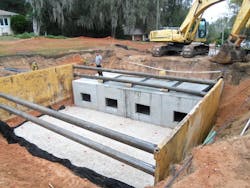About the author: Steve Kingsland is regional sales and marketing manager for Oldcastle Precast. Kingsland can be reached at 888.965.3227.
The city of Clermont, Fla., and the Lake County (Fla.) Water Authority wanted to improve the water quality of Lake Minnehaha, one of the largest of the Clermont chain of lakes. The key to protecting the lake’s water quality was to design a drainage structure that would capture and treat storm water from a local drainage basin while reducing pollutant loads, improving the quality of the water flowing into the lake and the Clermont chain, and providing an element of flood control.
In a 2012 press release, city engineer Tamara Richardson said, “The city council’s direction has been to improve the water quality of the chain of lakes. Lake County Water Authority has the same goal for improving the chain. We’re trying to get the biggest bang for the buck.”
With this goal in mind, the city of Clermont and the Lake County Water Authority made a commitment to modernize the older systems that directly discharged untreated storm water into the Clermont chain and collaborated on a $599,110 project at the Disston Avenue drainage basin to capture and treat storm water before it enters Lake Minnehaha.
How It Works
The storm water drainage treatment structure was designed as a train system and included precast concrete baffle boxes for pretreatment, and Oldcastle Precast’s Storm Capture underground concrete storage and maintenance modules to capture and detain storm water. In order to prevent sediment from entering the storage system and clogging the exfiltration surface, the baffle boxes remove sediment as well as floatables such as trash, leaves and grass. In order to remove unwanted nutrients before providing groundwater recharge, the module system gathers and holds the storm water before allowing it to percolate through the sandy soil under the open-bottom modules.
All of the storm water management components for the new drainage train system were supplied by Oldcastle Precast of Orlando, Fla. The company manufactured three individual precast concrete drainage systems for the project. Each system consists of an upstream baffle box for initial treatment of the roadway surface storm water runoff before it enters a series of 22-, 16- and 24-ft layouts of Storm Capture modules. These modules are designed for detention and exfiltration into the ground, in addition to access for maintenance. On Disston Avenue, the modules are 5-ft-tall and open bottom with internal conveyance passageways that allow storm water to flow among all modules.
In all, Oldcastle Precast supplied six modified curb inlets, one 5-ft-diameter doghouse storm manhole, three 4-ft-by-13-ft-8-in.-by-7-ft baffle boxes, 62 Storm Capture modules, three areas of Storm Capture maintenance modules, and cast iron frames and covers for all structures.
This drainage method allows storm water runoff to flow into the drainage system through precast curb inlets before being piped through storm manholes and eventually to the treatment train system consisting of the inline baffle boxes and modules. During storm events, the storm water will exfiltrate from the modules into the ground to replenish local aquifers.
The baffle boxes are a non-proprietary design by BESH engineers. They allow solids in the water to be removed through sedimentation and screening. Sediment and floatables then can be removed from the baffle boxes through any of the three access openings in each box using a standard vac truck. By keeping sediment and debris out of the modules, system maintenance is confined primarily to the baffle boxes for simplification and efficiency. This design aspect prevents the exfiltration surface under the modules from plugging up and provides maximum groundwater recharge. Access manways into the maintenance modules also are provided in the event that future maintenance is required.
The three drainage systems were installed underground beneath Disston Avenue, a heavily traveled residential street in the Orlando area. Installation of the entire system took 60 days. Trench boxes were used to support the sides of the excavation while the precast concrete baffle boxes and Storm Capture modules were installed using an excavator. Each of the three systems had to be installed individually while the roadway reopened to local traffic between the construction of each system.
Environmental Benefits
The modules provide a valuable dual function for the Disston Avenue Improvement Project—a groundwater recharge and flood control system, with a long-standing design focused on efficiency and accessibility for inspection and maintenance.
Among the many benefits of the project is the value of maintaining healthy wildlife and plant habitats and providing safe outdoor recreation for residents and visitors. The Disston Avenue basin is one of several projects that is anticipated to significantly reduce pollutant loadings and improve water quality in Lake Minnehaha and the Clermont chain.
The Clermont chain “is part of the identity of south Lake County and is a popular destination for residents and non-residents alike,” city engineer Tamara Richardson told the Orlando Sentinel on May 31, 2012. “It is important to the community and the ecology to maintain a healthy lake system for the enjoyment of future generations, as well as promoting a diverse ecosystem unique to Florida.”
Lake Minnehaha is designated as an Outstanding Florida Water by the state Department of Environmental Protection because of its natural beauty and attributes. The designation comes with certain regulatory requirements that give the waterway special protection. City leaders said it is important to keep the lake unspoiled.
Download: Here


